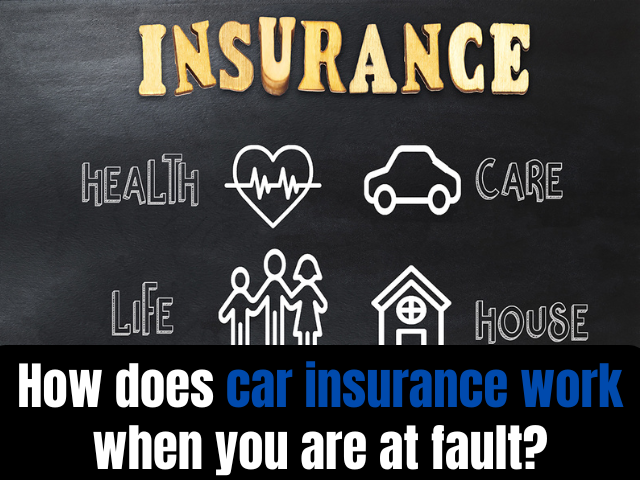Car accidents can be stressful and overwhelming experiences, especially when you’re the one at fault. Understanding how car insurance works in these situations is crucial for every driver. This comprehensive guide will walk you through the intricacies of at-fault car insurance, helping you navigate the complex world of claims, coverage, and consequences.
Whether you’re a new driver or simply looking to brush up on your insurance knowledge, this article will provide valuable insights into what happens when you’re responsible for a car accident.
What Does “At-Fault” Mean in Car Insurance?

Before diving into the specifics, it’s essential to understand what “at-fault” means in the context of car insurance:
- Definition of At-Fault:
Being “at fault” in a car accident means that you’re determined to be primarily responsible for causing the collision. This determination is usually made by insurance adjusters, police reports, or sometimes through legal proceedings. - Degrees of Fault:
It’s important to note that fault isn’t always black and white. In some cases, both parties may share responsibility for an accident, leading to a percentage-based allocation of fault. - No-Fault vs. At-Fault States:
The impact of being at fault can vary depending on whether you live in a “no-fault” or “at-fault” state. We’ll explore these differences in detail later in the article.
READ MORE: How does motor vehicle insurance work
Types of Car Insurance Coverage
To understand how insurance works when you’re at fault, you need to be familiar with the different types of coverage:
- Liability Coverage:
- Bodily Injury Liability: Covers injuries to others when you’re at fault.
- Property Damage Liability: Pays for damage to other people’s property.
- Collision Coverage:
Covers damage to your own vehicle, regardless of fault. - Comprehensive Coverage:
Protects against non-collision-related damage, such as theft or natural disasters. - Personal Injury Protection (PIP):
Covers medical expenses and lost wages for you and your passengers, regardless of fault. - Uninsured/Underinsured Motorist Coverage:
Protects you if you’re hit by a driver with insufficient or no insurance.
The Claims Process When You’re At Fault

When you’re responsible for an accident, the claims process typically follows these steps:
- Report the Accident:
Contact your insurance company as soon as possible to report the incident. Provide accurate details about what happened. - Investigation:
Your insurance company will assign an adjuster to investigate the claim. They may interview witnesses, review police reports, and assess vehicle damage. - Fault Determination:
Based on the evidence, the insurance company will determine who was at fault and to what degree. - Coverage Activation:
If you’re found at fault, your liability coverage will kick in to cover the other party’s damages and injuries. - Claim Settlement:
Your insurance company will negotiate with the other party or their insurer to settle the claim. - Deductible Payment:
If you have collision coverage and want to repair your vehicle, you’ll need to pay your deductible.
Financial Implications of Being At Fault
Being responsible for an accident can have several financial consequences:
- Insurance Premium Increases:
Your insurance rates are likely to go up after an at-fault accident. The increase can vary depending on the severity of the accident and your prior driving record. - Surcharges:
Some insurers may apply a surcharge to your policy for a certain period following an at-fault accident. - Loss of Discounts:
You may lose safe driver discounts or other premium-reducing benefits. - Out-of-Pocket Expenses:
If your coverage limits are insufficient to cover all damages, you may be personally responsible for the excess amount.
At-Fault Accidents in the No-Fault States
Some states operate under a no-fault insurance system, which can affect how at-fault accidents are handled:
- Personal Injury Protection (PIP):
In no-fault states, each driver’s insurance covers their medical expenses and lost wages, regardless of who caused the accident. - Threshold for Lawsuits:
No-fault states often have restrictions on when an injured party can sue the at-fault driver. This usually involves meeting a certain threshold of injury severity or medical expenses. - Property Damage Claims:
Even in no-fault states, property damage claims typically follow traditional fault-based rules.
READ MORE: How motor insurance premium is calculated
Protecting Yourself After an At-Fault Accident
If you find yourself at fault in an accident, consider these steps to protect your interests:
- Avoid Admitting Fault:
While it’s important to be honest, avoid explicitly admitting fault at the scene. Let the insurance companies determine responsibility. - Document Everything:
Take photos of the accident scene, gather witness information, and keep records of all communications related to the incident. - Consider Legal Counsel:
In cases of severe accidents or disputes over fault, consulting with an attorney specializing in car accidents may be beneficial. - Review Your Coverage:
After an at-fault accident, it’s a good time to review your insurance policy and consider adjusting your coverage levels.
Long-Term Impact on Your Driving Record
At-fault accidents can have lasting effects on your driving record:
- Points on Your License:
Many states use a point system, where at-fault accidents add points to your driving record. - Insurance Record:
Most insurance companies consider your driving history for the past 3-5 years when setting premiums. - Employment Concerns:
If you drive for work, an at-fault accident could potentially impact your employment.
Strategies to Mitigate the Impact of At-Fault Accidents
While you can’t change the past, there are ways to minimize the long-term effects of an at-fault accident:
- Accident Forgiveness:
Some insurance companies offer accident forgiveness programs that prevent rate increases after your first at-fault accident. - Defensive Driving Courses:
Completing a defensive driving course may help offset some of the negative impacts on your insurance rates. - Shopping for New Insurance:
After an at-fault accident, it may be worth shopping around for new insurance quotes, as different companies weigh accidents differently. - Maintaining a Clean Record:
Focus on safe driving habits to avoid future incidents and gradually improve your insurance standing.
Understanding how car insurance works when you’re at fault is crucial for every driver. While being responsible for an accident can have significant financial and legal implications, knowing your rights, responsibilities, and options can help you navigate the aftermath more effectively. Remember that insurance policies and laws can vary by state and provider, so it’s always best to familiarize yourself with your specific policy details and local regulations.
By staying informed, driving safely, and maintaining appropriate coverage, you can protect yourself and others on the road. In the event of an at-fault accident, remember to stay calm, follow proper procedures, and work closely with your insurance provider to resolve the situation as smoothly as possible.







Leave a Reply